The Problem with Velocity Profiles
The velocity profile of thin disk galaxies is a riddle worth pondering. Studies have shown that the velocity of stars in a galaxy rise to a peak as one leaves the center, and then stays flat as one looks further out. Newtonian gravitational theory can predict the peak correctly, but there must always be a decline.
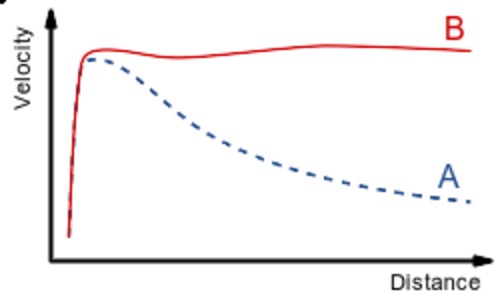
From Galaxy rotation curve, with A is the Newtonian prediction, B is the data.
There are two parts to any force law: the cause and the effect. Consider the elliptical motion of the Moon around the Earth. The cause is the gravitational field of the Earth acting like a point source. The effect is the motion of the Moon around the Earth.
The rules of algebra allow one to cancel the mass of the Moon on both sides. Einstein appreciated the depth of that step, the equivalence of gravitational and inertial masses. One can spot a core message of general relativity in this classical context. How much the Moon weighs is not relevant to its own gravitational motion. Gravity demands all masses orbit this way due to the Earth's gravitational field.
One can solve this equation to get the circular velocity:
Both G and the mass of the Earth are fixed numbers. Go out a larger distance and the velocity must drop. While the equation for a potential is quite different for a disk galaxy, the fact remains that the circular velocity must fall with distance.
There are two proposals to fix this issue that have received much research attention. The first is Modification Of Newtonian Dynamics, or MOND. When gravitational fields are weak, some ten orders of magnitude smaller than the acceleration of gravity on the surface of the Earth, then the form of the force law changes from a one over distance squared to one over distance. The proposal works great for the rotation profile of galaxies, closely matching over a hundred cases. MOND also does well with the Tully-Fisher relation. For even larger scales such as clusters of galaxies, MOND is not as successful. See The MOND Pages for a balanced assessment of the technical issues.
Dark matter is another proposal that tries to solve the riddle. Here one modifies the cause to include enough dark matter to produce the velocity curves that are seen. The proposal does not work so well for the rotation profile of galaxies because there are few constraints on the distribution of dark matter in space. Dark matter is viewed as being a useful hypothesis for cosmology. A significant problem is that many dark matter candidates have been considered and rejected. Dark matter appears as the only player that can explain the weak gravitational lensing happening as a bullet cluster passes through another. In MOND, the gravitational and inertial masses must be exactly on top of each other. Yet the data says otherwise, the matter we see is in a different place from the gravitational potential. That is possible with dark matter.
The Light Matter Proposal
The light matter proposal starts from the simplest observation: galaxies emit light. They do so by converting mass into photons. We need to account for this mass change somewhere in our velocity profile equation. While the amount of mass that gets consumed by fusion is exceptionally small, the change in the form of the velocity profile equation needs to be investigated.
Now consider the Earth in an elliptical orbit around the Sun. The numbers will change, but much of the math remains the same. A difference is that the Sun undergoes fusion, where two hydrogen atoms fuse to create one helium atom. Because the rest mass of the two hydrogen atoms is more than one helium atom, the mass decrease according to Einstein's most famous equation - E = m c2 - releases an enormous amount of energy. About 4 billion kilograms of mass are converted to various forms of energy per second. While that may sound huge, in the context of the Sun such a mass is not. The mass of the Sun is more than twenty orders of magnitude larger.
The gravitational potential of the Sun can be split into two components: the bulk which does not change in time, and the mass that does change in time due to fusion. Because these two masses enter as a sum into the potential, we can treat the Sun's mass as a constant. We cannot measure rotational speeds of planets to over ten significant digits, so the detail about fusion gets lost.
Finally, consider the rotation of stars in a thin disk galaxy. A number of things change. First, the source can no longer be viewed as a point. The potential function is no longer just the mass over the distance. The math problem was tackled in the 1960s by Alar Toomre using elliptical integrals. Later techniques used modified Bessel functions. With modern symbolic math programs, the rotation profile of a disk galaxy can be calculated by a computer in less time than it takes to type in the expression. Even with the fancier potential, a decline in circular velocity as the distance increases from the center of the galaxy remains unavoidable, yet inconsistent with observation.
Another change is that fusion happens for the masses effected by the force of gravity. All forces are a change in momentum, the product of mass times velocity. By the product rule of calculus:
The first term is the well-known mass times acceleration. The second term is the stuff of rocket science. Rockets are launched in a particular direction, and that is the direction of this term. How would stars undergoing fusion contribute to this term? The photons go out in every direction, so when everything is even, there is no direction. A star is not a rocket.
Let's review why circular motion leads to the centripetal force that points radially. The velocity is perpendicular to the radius (see figure 2a).
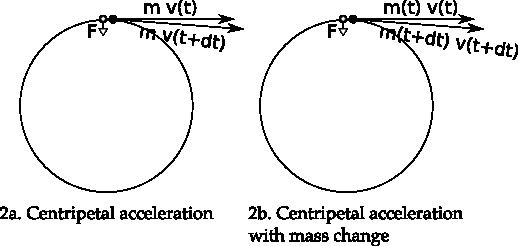
Momentum is the product of mass times velocity, so at a time t, the momentum is perpendicular to the radius. A short time later, the star has moved along an elliptical path, retaining its momentum perpendicular to the radius. It is the direction of momentum that has changed. The only way to change momentum is through a force. The re-directional force points along the radius. The centripetal force of moving along an elliptical path is balanced by the gravitational force from other stars in the galaxy.
For a star undergoing fusion in an elliptical orbit, the mass being held in orbit decreases (see figure 2b). As a star loses mass, it takes less force to keep it in place. Would that translate into the star going faster? Consider a speed skater with several weights going around a corner. The skater is doing everything he can to stay on the path. He lets go of weights in the turn. He works just as hard as before, but can now go faster because he weighs less.
The next step in solving the riddle is to determine what function one needs to use for the change in mass per unit of time. Start by defining a value for the fusion rate at the center of the galaxy:
Go out some arbitrary distance. Can we say something about that rate of fusion based on what happens at the center of the galaxy?
The change in mass as a function of distance from the center of the galaxy can be determined from observation. One uses the luminosity profile which has the form of an exponential decay along with assumptions about the mass to light ratio. For thin disk galaxies, the rate of change in the mass per unit area is
where Rd is a length scale for the decay in the density, often on the order of 2-6 kpc.
I propose a strict proportionality between the amount of mass and the amount of fusion going on: the more mass, the more fusion, the less mass, the less fusion. At the center of the galaxy:
Gamma is a coupling factor. Consider it a free parameter in the proposal.
For this to work at different places away from the center, the form of m(t) must match that of the luminosity profile:
After eliminating the unit area, take the derivative of this function with respect to time:
Substitute this into the force equation:
Notice something miraculous: we again get to cancel out the small m mass. This time it feels fortuitous because it happened based on the exponential form of the luminosity profile.
The solution for the circular velocity comes out from the binomial equation:
For the Earth/Moon system, gamma equals zero and we can see the simple square root result. When R is much smaller than the length scale Rd, the velocity will be similar to that for Newtonian theory. For large enough values of the ratio, fusion will cease, making gamma equal to zero and reverting to Newtonian theory. Between those two limits, for an exponentially decaying disk galaxy, there will be a linear contribution to the velocity profile happening because stars undergo fusion. A linear increase in the circular velocity from the fusion term with distance sounds quite odd, but it is the way the math cards happen to be for this proposal.
There are two real solutions, a positive and negative circular velocity. For circular motion, there are two directions, clockwise and counterclockwise. With the signs both negative, the magnitude of the resulting negative velocity is greater than the Newtonian solution. With the signs different, the positive rotational velocity is smaller. Because a decrease in mass should lead to faster speeds, I interpret the same sign solution as the physical one.
Deriving the Velocity Profile Equation
What potential should one use for a thin, exponentially decaying disk galaxy? Answering this question will require a digression because the math is not trivial. Feel free to skip this section and go directly to the plots, they are more fun :-)
If you are interested in the details of the technical approach, get a hold of "Galactic Dynamics", by James Binney and Scott Tremaine, and focus in on Section 2.6, "The Potentials of Disks". I will provide an impression of how to get to the velocity profile, but a number of the details are beyond my reach. If you have questions on this part of the blog, please consult the source.
Rewrite the Laplace equation in cylindrical coordinates, so
becomes:
The radius is R, phi is an angle, and z is a complex number.
One wants to separate the variables so there are three functions:
The magic of separation of variables is used to get two darn similar equations made up of these parts linked by a constant (k2) :
Put these separate equations on separate lines and rearrange slightly:
The first two equations can be solved with exponential functions. The third equation requires Bessel functions:
Only the Bessel J function is used. While not discussed in Galactic Dynamics, I think it has to do with the behaviour at the origin, where Bessel J is equal to unity, but Bessel Y is not defined (small values of R evaluate to large negative numbers). Put the solutions all back together to define a potential:
This is where the math starts going beyond anything I will understand. They talk about a generalized surface function, Σ(R). Using the miracle powers of Hankel transformations which are similar to Fourier transformations, they define the inverse of this as an "S(k)" function.. for a an exponential disk (eq. 2-158, first edition) is:
Plug this into an integral with a Bessel function to get the potential.
If one consults two of those old technical books on integrals, Gradshtey and Ryzhik, and Abramowitz and Stegun, then together you can evaluate the integral:
[Math sidebar] I know this blog is math heavy. That is mildly ironic because this is purely classical stuff, nothing so difficult as quantum mechanics. I tried to "follow along" with Mathematica. The program of course had the Bessel functions, and in the equation above, the modified Bessel functions. Yet it did not find these compact results, choosing instead to write the integrals as MeijerG functions, the proverbial granddaddy of special functions. Special functions can be defined in a few different ways, so they are playing it safe. I thought it was cool that this math was too hard for Mathematica to express in a compact fashion.
[end math sidebar]
Recall the circular velocity expression:
One needs to take the derivative of the potential. That requires a dive into the appendix to justify:
One does that magic with finding a compact expression for an integral with Bessel functions, and the circular velocity for Newtonain gravitational theory is:
This is the equation needed to make the velocity profile of a disk galaxy (with no bulge).
Velocity Profile Plots
Plot the dimensionless velocity profile for a disk galaxy:
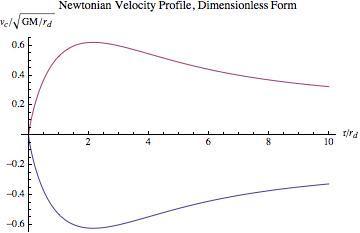
This is just like Galactic Dynamics figure 2.17 (omitting the negative velocities), with a peak around 2 R/Rd of a bit over 0.6. I am more interested in seeing the real velocities. I used the mass for the disk of the Milky Way galaxy (1.2 x 1041 kg) and scale factor 2.5 kpc.
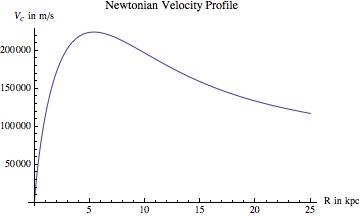
The curve has the same shape. The peak velocity is a touch over 220 km/s, which is similar to what happens in the Milky Way.
The same potential will be used to create a new velocity plot taking into account fusion happening within the stars in elliptical motion. There is one free parameter, gamma, set to 0.00009:
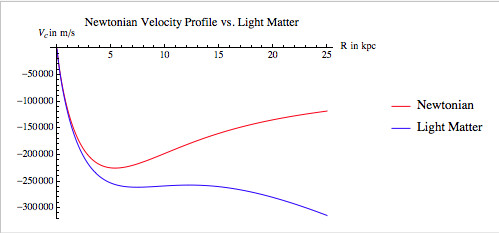
The peak velocity is slightly higher. The most important difference is the shape of the curve which is relatively flat from a few kpc out to more than 15 kpc. Note that the curve does start to increase at even greater distances. I don't think there is any information content in the negative sign, but graphed it that way to be honest.
The graph is sensitive to the value of gamma.
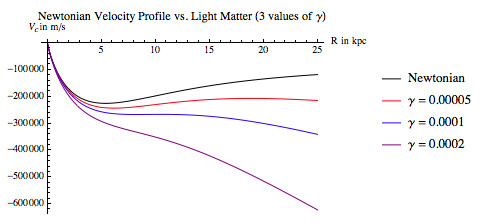
Increase it by an order of magnitude and one gets a straighter line. Decrease it by an order of magnitude and the graph looks like Newton's theory unaltered.
Discussion
A big open question for this proposal is why gamma should be about 10-4? Certainly Nature is not playing with a parameter until the velocity profile is flat. Here is one possibility. Fusion in stars happens near the core with the temperature on the order of 10 million degrees. How much of the energy of the fusion stays in the stars in order to maintain its state? The star uses most of the energy of fusion to have a 10 million degree core and resist gravitational collapse. The amount of energy that leaves might be the fraction between the temperature at the surface - thousands of degrees - versus the core, a difference of four orders of magnitude.
The bulge that appears in many galaxies including our own was ignored in this modeling. It is unclear how the bulge would change the resulting velocity profile.
A concern with using potential theory in this case is that this system is not conservative. While energy is conserved for the Universe, mass is leaving the galaxy as light energy in the three term model used here.
MOND is a daring hypothesis: gravity changes its form when the acceleration gets very small. Dark matter is a daring hypothesis: we don't know what it is, but there is even more of it than the stuff we see.
The light matter proposal in this initial phase is also bold. The fraction of mass involved in fusion is orders of magnitude beyond trivial. It is easy to appreciate those skilled in approximation to ignore the weight loss stars undergo to make light. The fraction of fusion mass is eliminated by a "lucky" cancellation. One is left with how the rate changes. The change in fusion rate should mimic the change in bulk mass. It is that algebraic trick based on observation that may allow the small amount of fusion to have a large effect.
If we can see something, then there is fusion going on. We may have to account for fusion in much cosmology work. Changing the form of equations has a huge impact.
Death to dark matter. Long live light matter.
A Mathematica notebook is available as a pdf or notebook.
COMMENT NOTE: I will delete comments from anyone who does not log into the site, whether positive or negative, it is simple to enforce. I have found such people are often impolite and make comments that are not worth reading. Let's stick to the technical issues (toss in a "personal suggestion" and I will delete those too).




Comments